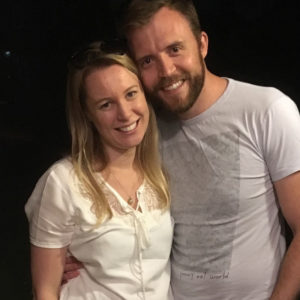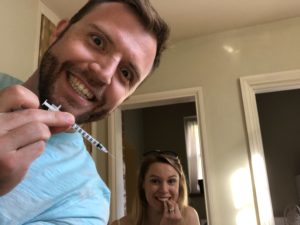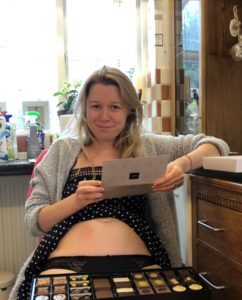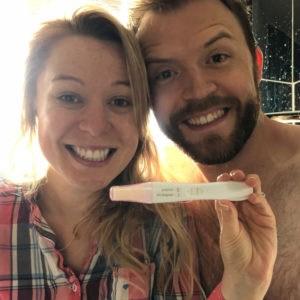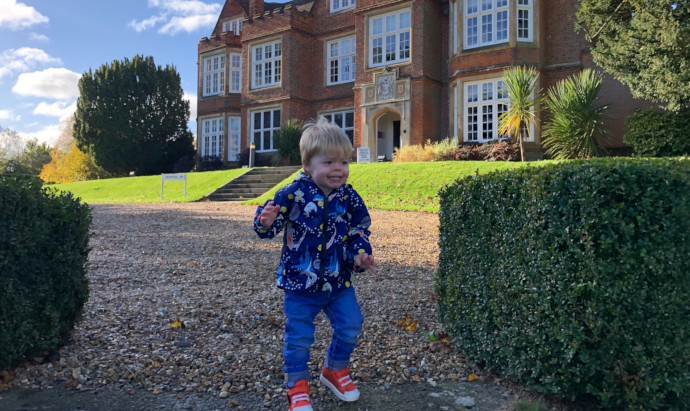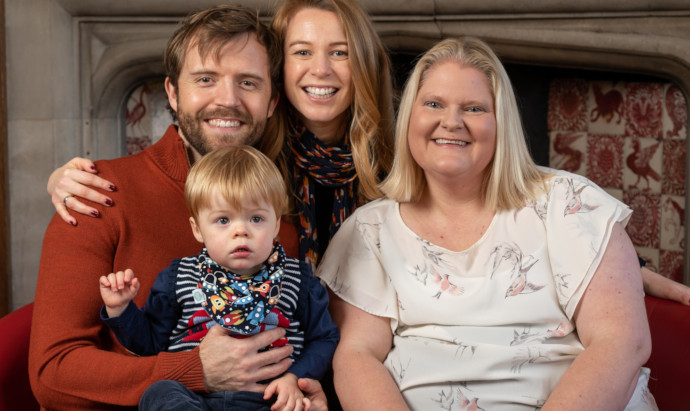I always wanted children, but I had never met the right person before I met Mark. He said that he didn’t mind if we didn’t have children, but I knew that he did really.
I wasn’t one of those girls who was desperate for children, but I just always thought that my life wouldn’t be complete if I didn’t have a child. Even as I was getting older and older, I thought there would always be IVF. I never thought for one minute that IVF at 40 wouldn’t work.
I am from South Africa and have lived in the UK for 19 years. Before the pandemic I was working at Canary Wharf in London and met my husband when I was 38 and Mark was 39. We met on Tinder; there are a lot of dodgy men on Tinder – but he was normal with a nice family!
We got together in March 2017 and on Christmas Eve he had proposed. We got married in Cape Town in 2018.
IVF at 40
If we wanted a family, we needed to get a move on. I have always had a regular cycle and know almost to the day when I am ovulating. So, because of my age, when it didn’t happen quickly, we went to our GP for advice. She referred us to the Lister Hospital for testing and the Lister hospital suggested we got the AMH test done privately as this would give us a result more quickly. [An AMH test provides an indication of ovarian reserve.]
My AMH level was good for my age, so it would be possible for me to use my own eggs for fertility treatment, but I was warned that egg quality and quantity decline over 35. When Mark’s results came back the morphology and motility of his sperm was not very high.
After doing all that our GP and the Lister hospital said we were eligible for a round of NHS-funded IVF treatment – I was over 40 so was only allowed one funded cycle. It was December 2019 when it was confirmed and we started treatment in January 2020.
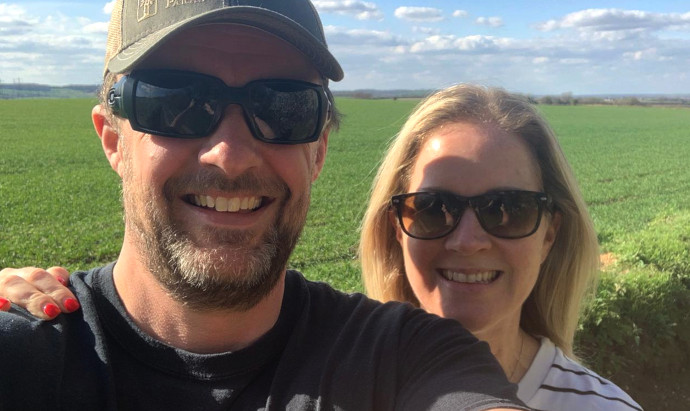
NHS IVF funding for one cycle
We chose to go to Bourn Hall Cambridge as my friend had been successful there and other people said they had had good experiences there.
I threw everything at the situation: I changed my diet, changed my products, stopped drinking alcohol, took all the supplements, drank lots of healthy smoothies, and spoke to a fertility nutritionist.
Egg collection was at the start of March 2020. It was still the early days of the pandemic and no one really knew what was happening. This fresh round created 4 embryos but only two embryos got to day three and were both transferred at three days.
Mark was allowed in for the egg collection and embryo transfer, but when it came to the eight-week scan he wasn’t allowed in because of Covid (note this has now changed). The scan showed I was pregnant.
Losing the pregnancy
My gut instinct told me I needed more scans mainly because of my age.
For reassurance, I paid for a Harmony scan and a blood test at the Lister Hospital a few weeks later. Mark had to wait outside the hospital in the car and I was just praying for the best outcome. But they couldn’t find a heartbeat; I had lost the pregnancy. They let Mark come in to see me and gave me the options of what to do next. They didn’t want me to go home and take a pill, so I decided to go for something called a manual vacuum aspiration which is unpleasant but meant I didn’t have to go into theatre, which they advised against due to covid.
It was the first time that I had ever been pregnant and that was our one funded IVF cycle done.
We then had to save money and pay for the next one.
More options for self-funded treatment
For the first round, they give you a protocol based on your results and medical history, as they don’t know how you are going to react to the medication, but for the next round they can use information from your previous response to treatment to tailor it to you.
For the first round we had ICSI, where the sperm is injected into the egg. For the second time I asked for IMSI, which magnifies the sperm to a higher level so it is easier to choose the best one – it is on the HFEA’s ‘unproven treatment’ list, but I wanted to do everything I could do to improve the chances.
Due to the ongoing pandemic Mark couldn’t come in with me this time. The treatment resulted in nine embryos, and four embryos made it to the five-day blastocyst stage.
Sadly, I miscarried this time too
The first time was a ‘missed miscarriage’ as I didn’t know I had lost it until I got the second scan, but this second time I was told it was something called a ‘blighted ovum’, where the embryo doesn’t develop and leaves an empty sac. I was told this time to miscarry naturally but by 10 weeks nothing had happened so I was advised by the Lister to take the pill.
Still due to the pandemic my husband wasn’t allowed in for the scan, so I had to walk back to the car and tell him. We were devastated. I kept thinking it was my age, IVF at 40 was never going to work, but I had to try to stay positive. [Note: this has now changed and partners can attend early pregnancy assessment scans]
I didn’t want to waste any time
I was okay although devastated. A lot of women get really down which I totally understand; maybe I am a bit harder than most. The first miscarriage was terrible and I was devastated after the second one, but I didn’t dwell on it. I just wanted to have another round; I didn’t want to waste any time.
I was producing eggs: I was still having regular periods, absolutely on time every month like clockwork. That is why I never lost hope – the struggle was trying to get my husband to take supplements!
We knew we had three more frozen embryos so that also gave us a bit of hope, so then it was a decision of when to start the next round. We ended up starting in January, using two of the frozen embryos.
Personally, if it hadn’t worked, I don’t think I would have gone down the route of using donated gametes. If I couldn’t use my own eggs or my husband’s sperm, I probably wouldn’t have had children.
We would have decided to enjoy our lives without them, earned our money, travelled the world.
Natural frozen transfer
I did quite a lot of research. That is one thing I would say to other people: do your research – I think it made all the difference as I felt more in control.
When I went for the consultation, we discussed the options for frozen embryo transfer, and the implications, and I asked about a ‘natural frozen transfer’ as a friend had mentioned this and the consultant said a natural cycle would be a good choice for me.
With a natural transfer you need to have regular periods and then you take just take progesterone to help the lining of the womb become receptive to the embryo, but not the other hormones to regulate the cycle. The transfer is timed around the natural cycle which is more unpredictable than a medicated cycle, but for some people it can be an option.
I went in for a scan, where they checked for my natural follicular development and the thickness of my womb lining. They timed transfer and said to come in on a particular day to do the transfer. I personally think that this is what helped, I was less stressed without the oestrogen hormones and it was much better for me, I think.
After the frozen round I did the pregnancy test at 4am on the date I was told to do it. It was positive but it looked weird, as though the dye had come out of the control line and gone to the test line. I didn’t quite understand what was going on and when I went to bed I Googled the result – it said it could be caused by high hormone levels and possibly twins.
When I went for the scan, I was just hoping for a heartbeat.
Mark had a look and cried
I left Mark in the car [Note: this has now changed and partners can attend early pregnancy assessment scans] and went into Bourn Hall for the eight-week scan. I couldn’t look at the screen; the nurse understood and after 10 seconds she said ‘you might want to call your husband – there are two heartbeats’. I couldn’t believe it!
I was allowed to call Mark on a video call and he had a look and he cried. He was really emotional; he was white as a ghost and we were very excited but obviously in a bit of shock – after two miscarriages you don’t think it is going to work.
I got to my due date at 37 weeks and I had our twins Matilda and Oliver at the Lister in October 2021, four months after turning 43.
Even if it hadn’t worked at least I would know that I tried everything – but it did all work out: after two miscarriages we got two babies, and having the twins was worth every bit of effort.
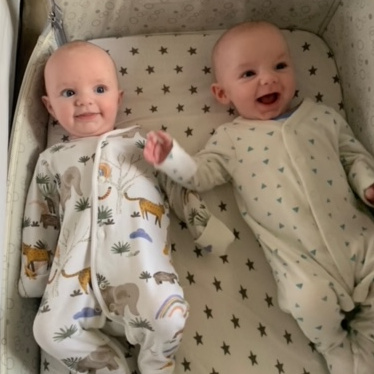
Mark adds: “Becoming a parent in my 40s has been a true blessing. Initially I felt such relief once the twins were delivered as the horrid feeling you develop following the miscarriages we suffered doesn’t leave you. That feeling was dismissed once Melanie gave birth and there was an overwhelming feeling of relief and pride. We consider ourselves very fortunate having been blessed with healthy twins.”


